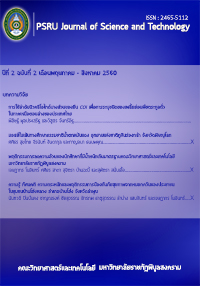การใช้ลำดับนิวคลีโอไทด์บางส่วนของยีน COI เพื่อการระบุชนิดของเพลี้ยอ่อนพืชตระกูลถั่วในภาคเหนือตอนล่างของประเทศไทย
Keywords:
ยีน COI, ดีเอ็นเอบาร์โค้ด, เพลี้ยอ่อนพืชตระกูลถั่ว, ภาคเหนือตอนล่างของประเทศไทย, COI gene, DNA barcode, Legume Aphids, Lower northern ThailandAbstract
บทคัดย่อ
ปัจจุบันการศึกษาถึงชนิดของเพลี้ยอ่อนนี้ยังมีอยู่อย่างจำกัดในประเทศไทยทั้งนี้การจำแนกชนิดยังคงมีความยากเนื่องจากมีลักษณะที่เด่นชัดน้อย ดังนั้นการศึกษาในครั้งนี้จึงได้ทำการระบุชนิดเพลี้ยอ่อนในพืชตระกูลถั่วที่สำรวจได้ในเขตพื้นที่ของจังหวัดสุโขทัย พิษณุโลก และเพชรบูรณ์ ด้วยเทคนิคดีเอ็นเอบาร์โค้ดจากลำดับนิวคลีโอไทด์บางส่วนของยีนในไมโทครอนเดีย647 bp จากปลาย 5’ ของยีน COI และสร้างเป็นแผนภูมิต้นไม้วิวัฒนาการ เมื่อวิเคราะห์ถึงความสัมพันธ์ทางวิวัฒนาการกับเพลี้ยอ่อนทั้ง 4 ชนิด ได้แก่ Aphis craccivora, A. gossypii, A. nerrii และ A.glycine ด้วยวิธี Maximum likelihood, Neighbor Joining และ Unweighted Pair Group Method with Arithmetic Meanพบว่า เพลี้ยอ่อนแต่ละชนิดสามารถจัดอยู่ในกลุ่มเดียวกันอย่างเห็นได้ชัดในทุกๆ วิธีและมีความแตกต่างของลำดับนิวคลีโอไทด์ภายในกลุ่มประชากรของเพลี้ยอ่อนแต่ละชนิดที่ต่ำซึ่งอยู่ระหว่าง 0.00-2.30 เปอร์เซ็นต์บ่งบอกได้ว่าการใช้ดีเอ็นเอบาร์โค้ดสามารถเป็นวิธีการที่ประสบผลสำเร็จได้เป็นอย่างดี ดังนั้น ดีเอ็นเอบาร์โค้ดสามารถประยุกต์ใช้เป็นเครื่องมือที่มีประสิทธิภาพต่อการระบุชนิดได้อย่างรวดเร็วAbstract
Nowadays, relatively few faunistic researches have been conducted on aphids in Thailand. Also, the identification of aphids is always difficult due to the shortage of easily distinguishable morphological characters. Hence, aphid species obtained from Sukhothai, Phitsanulok and Petchabun provinces were molecular identified using DNA barcoding in this time. A 647-bp fragment of mitochondrial DNA from the 5′ region of the mitochondrial cytochrome c oxidase 1 (COI) gene was also reconstructed for phylogenic trees. Based upon phylogenetic relationship among four aphid species i.e. Aphis craccivora, A. gossypii, A. nerriiand A.glycineusing Maximum likelihood, Neighbor Joining andUnweighted Pair Group Method with Arithmetic Meananalyses,it was found that in eachaphid species was well differentiated and assembled a clade with high supportin all methodsand sequence variation within species was low, averaging just 0.00–2.30 percent. In addition, this result implied that DNA barcoding was successful in discrimination of aphid species. Therefore, DNA barcode can be applied as an effective tool for rapid species identification.
Downloads
Published
How to Cite
Issue
Section
License
กองบรรณาธิการขอสงวนสิทธิ์ในการปรับปรุงแก้ไขตัวอักษรและคำสะกดต่างๆ ที่ไม่ถูกต้อง และต้นฉบับที่ได้รับการตีพิมพ์ในวารสาร PSRU Journal of Science and Technology ถือเป็นกรรมสิทธิ์ของคณะวิทยาศาสตร์และเทคโนโลยี มหาวิทยาลัยราชภัฏพิบูลสงคราม และ
ผลการพิจารณาคัดเลือกบทความตีพิมพ์ในวารสารให้ถือมติของกองบรรณาธิการเป็นที่สิ้นสุด







